Evidence Portfolio Case Study 2022
VerifiedAdded on 2022/10/13
|9
|1794
|7
AI Summary
Contribute Materials
Your contribution can guide someone’s learning journey. Share your
documents today.
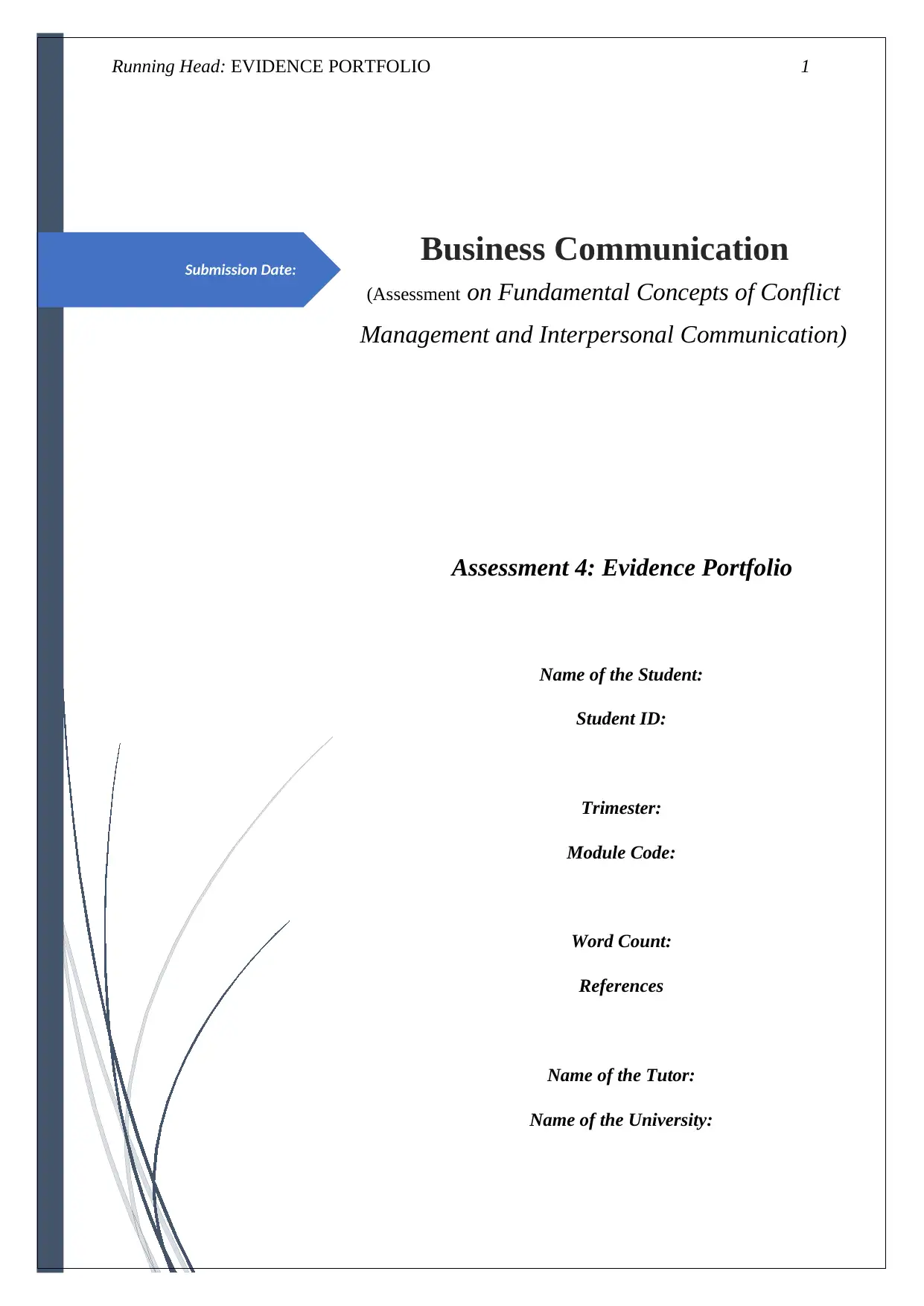
Submission Date:
Running Head: EVIDENCE PORTFOLIO 1
Business Communication
(Assessment on Fundamental Concepts of Conflict
Management and Interpersonal Communication)
Assessment 4: Evidence Portfolio
Name of the Student:
Student ID:
Trimester:
Module Code:
Word Count:
References
Name of the Tutor:
Name of the University:
Running Head: EVIDENCE PORTFOLIO 1
Business Communication
(Assessment on Fundamental Concepts of Conflict
Management and Interpersonal Communication)
Assessment 4: Evidence Portfolio
Name of the Student:
Student ID:
Trimester:
Module Code:
Word Count:
References
Name of the Tutor:
Name of the University:
Secure Best Marks with AI Grader
Need help grading? Try our AI Grader for instant feedback on your assignments.
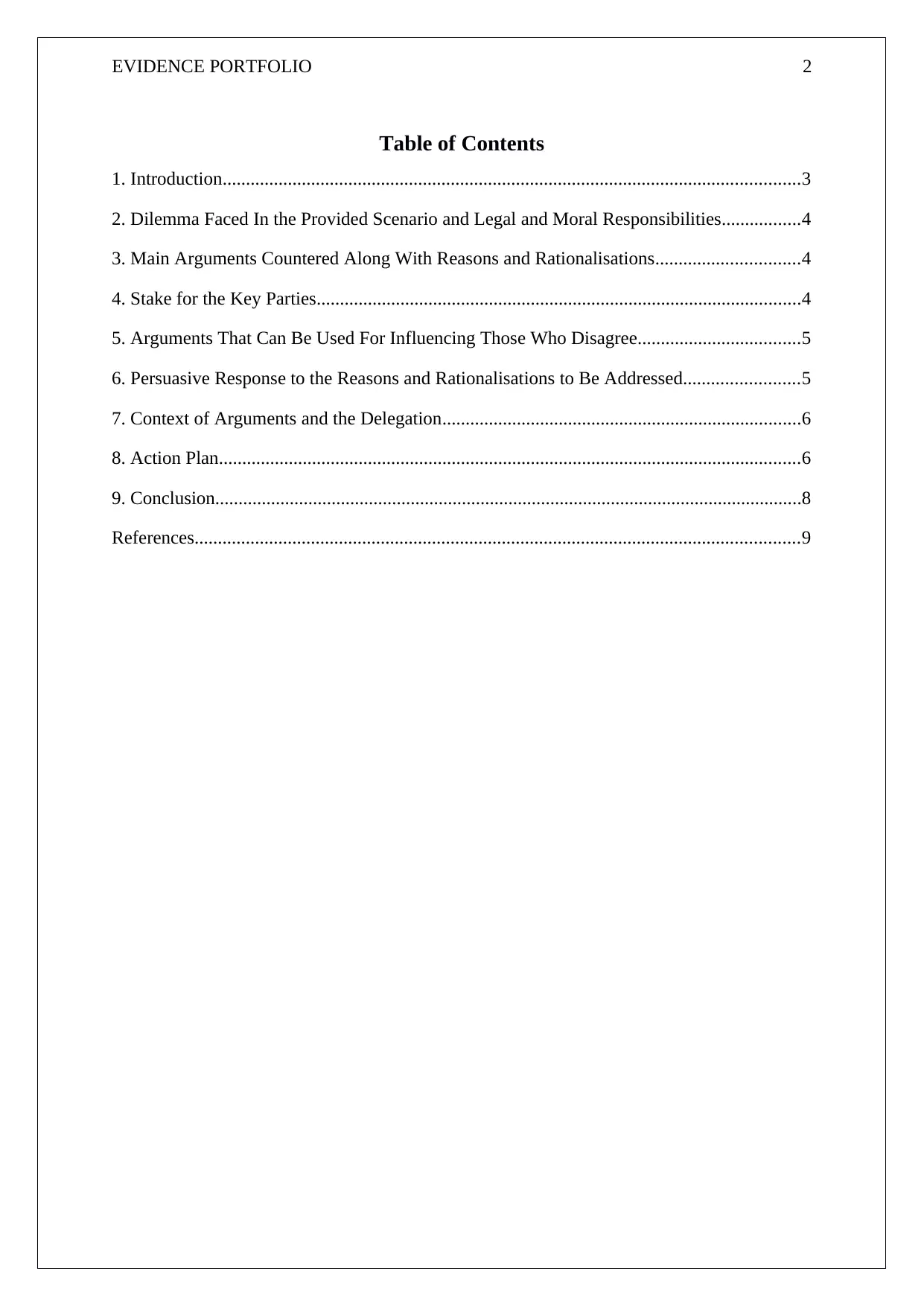
EVIDENCE PORTFOLIO 2
Table of Contents
1. Introduction............................................................................................................................3
2. Dilemma Faced In the Provided Scenario and Legal and Moral Responsibilities.................4
3. Main Arguments Countered Along With Reasons and Rationalisations...............................4
4. Stake for the Key Parties........................................................................................................4
5. Arguments That Can Be Used For Influencing Those Who Disagree...................................5
6. Persuasive Response to the Reasons and Rationalisations to Be Addressed.........................5
7. Context of Arguments and the Delegation.............................................................................6
8. Action Plan.............................................................................................................................6
9. Conclusion..............................................................................................................................8
References..................................................................................................................................9
Table of Contents
1. Introduction............................................................................................................................3
2. Dilemma Faced In the Provided Scenario and Legal and Moral Responsibilities.................4
3. Main Arguments Countered Along With Reasons and Rationalisations...............................4
4. Stake for the Key Parties........................................................................................................4
5. Arguments That Can Be Used For Influencing Those Who Disagree...................................5
6. Persuasive Response to the Reasons and Rationalisations to Be Addressed.........................5
7. Context of Arguments and the Delegation.............................................................................6
8. Action Plan.............................................................................................................................6
9. Conclusion..............................................................................................................................8
References..................................................................................................................................9
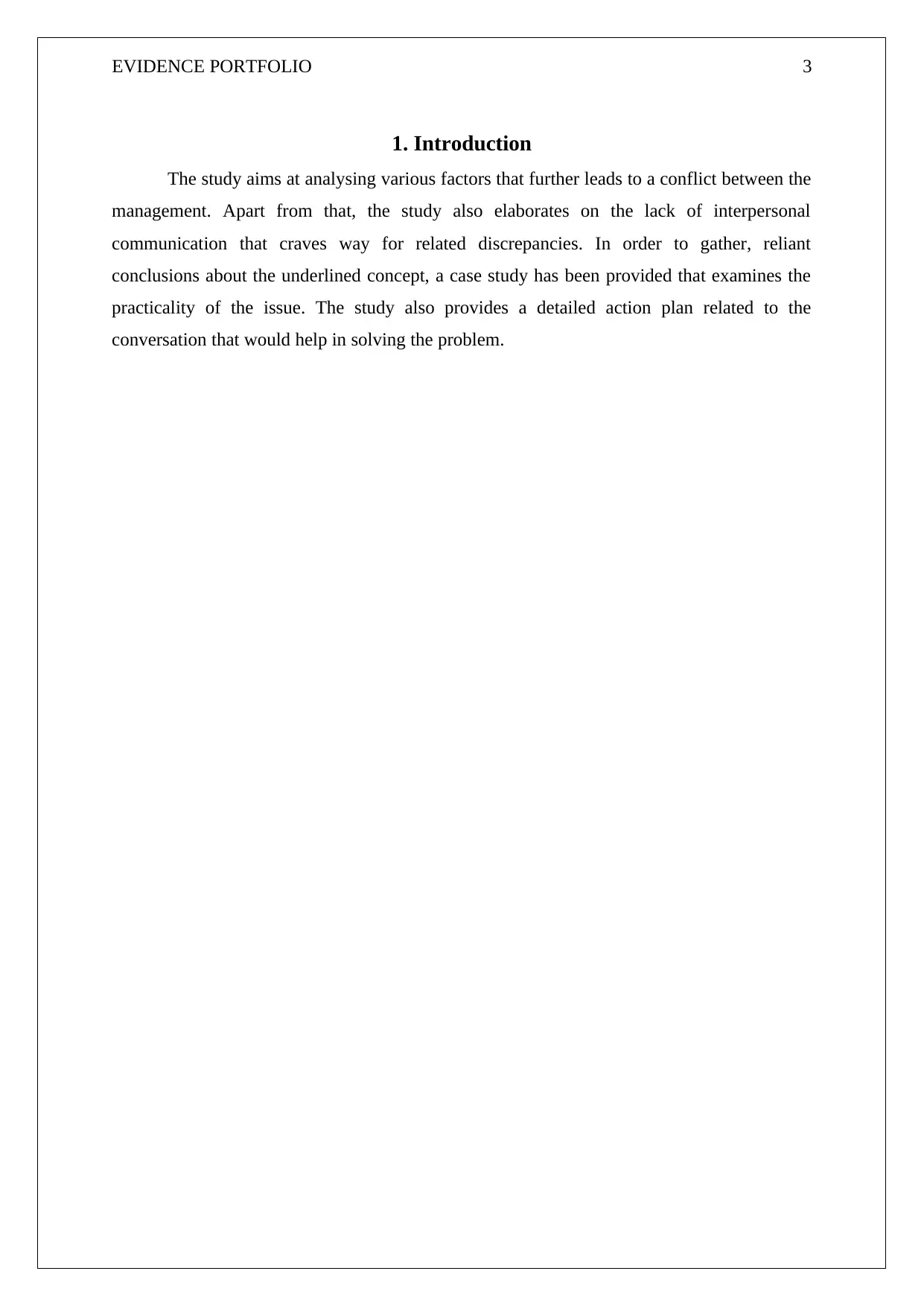
EVIDENCE PORTFOLIO 3
1. Introduction
The study aims at analysing various factors that further leads to a conflict between the
management. Apart from that, the study also elaborates on the lack of interpersonal
communication that craves way for related discrepancies. In order to gather, reliant
conclusions about the underlined concept, a case study has been provided that examines the
practicality of the issue. The study also provides a detailed action plan related to the
conversation that would help in solving the problem.
1. Introduction
The study aims at analysing various factors that further leads to a conflict between the
management. Apart from that, the study also elaborates on the lack of interpersonal
communication that craves way for related discrepancies. In order to gather, reliant
conclusions about the underlined concept, a case study has been provided that examines the
practicality of the issue. The study also provides a detailed action plan related to the
conversation that would help in solving the problem.
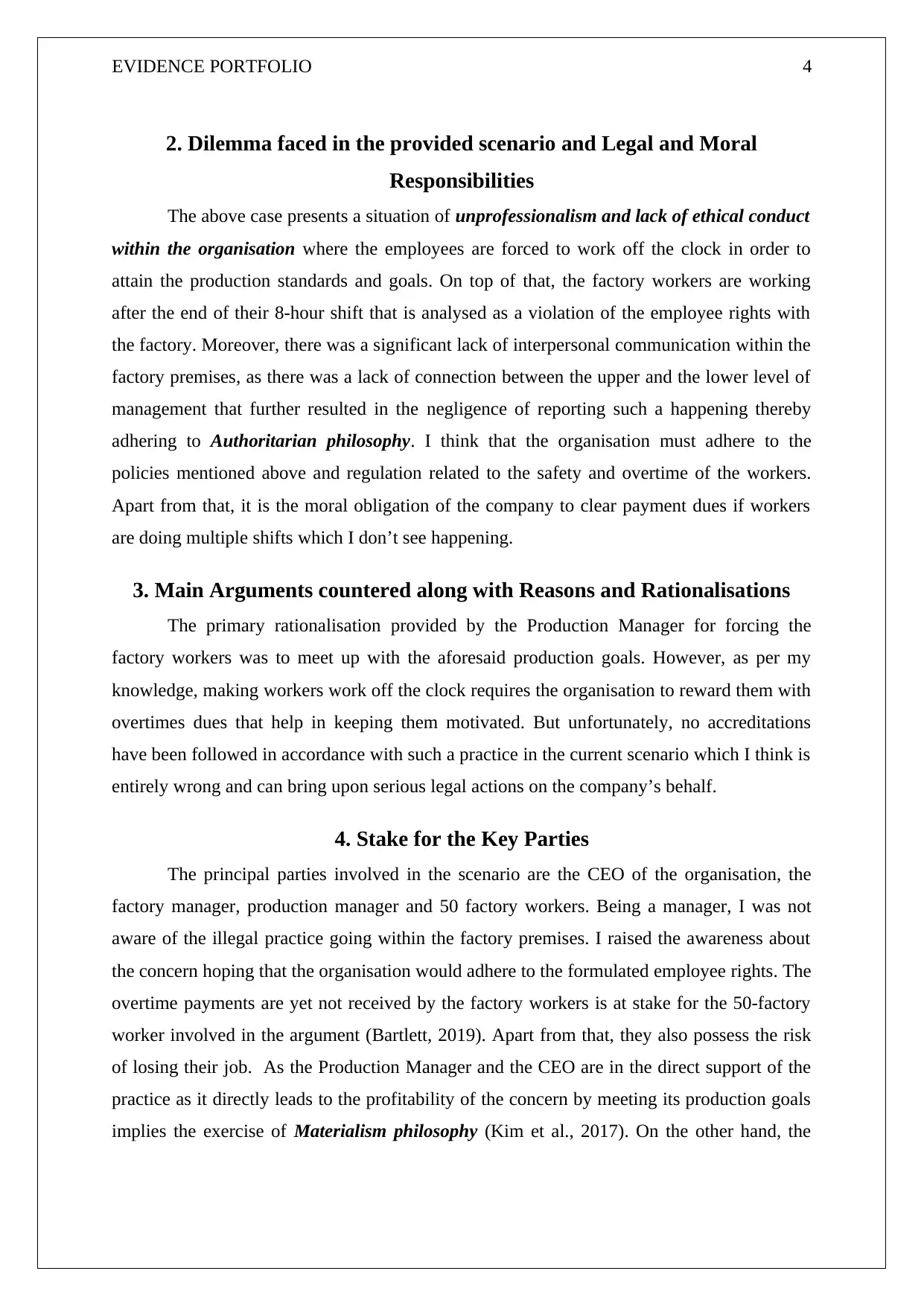
EVIDENCE PORTFOLIO 4
2. Dilemma faced in the provided scenario and Legal and Moral
Responsibilities
The above case presents a situation of unprofessionalism and lack of ethical conduct
within the organisation where the employees are forced to work off the clock in order to
attain the production standards and goals. On top of that, the factory workers are working
after the end of their 8-hour shift that is analysed as a violation of the employee rights with
the factory. Moreover, there was a significant lack of interpersonal communication within the
factory premises, as there was a lack of connection between the upper and the lower level of
management that further resulted in the negligence of reporting such a happening thereby
adhering to Authoritarian philosophy. I think that the organisation must adhere to the
policies mentioned above and regulation related to the safety and overtime of the workers.
Apart from that, it is the moral obligation of the company to clear payment dues if workers
are doing multiple shifts which I don’t see happening.
3. Main Arguments countered along with Reasons and Rationalisations
The primary rationalisation provided by the Production Manager for forcing the
factory workers was to meet up with the aforesaid production goals. However, as per my
knowledge, making workers work off the clock requires the organisation to reward them with
overtimes dues that help in keeping them motivated. But unfortunately, no accreditations
have been followed in accordance with such a practice in the current scenario which I think is
entirely wrong and can bring upon serious legal actions on the company’s behalf.
4. Stake for the Key Parties
The principal parties involved in the scenario are the CEO of the organisation, the
factory manager, production manager and 50 factory workers. Being a manager, I was not
aware of the illegal practice going within the factory premises. I raised the awareness about
the concern hoping that the organisation would adhere to the formulated employee rights. The
overtime payments are yet not received by the factory workers is at stake for the 50-factory
worker involved in the argument (Bartlett, 2019). Apart from that, they also possess the risk
of losing their job. As the Production Manager and the CEO are in the direct support of the
practice as it directly leads to the profitability of the concern by meeting its production goals
implies the exercise of Materialism philosophy (Kim et al., 2017). On the other hand, the
2. Dilemma faced in the provided scenario and Legal and Moral
Responsibilities
The above case presents a situation of unprofessionalism and lack of ethical conduct
within the organisation where the employees are forced to work off the clock in order to
attain the production standards and goals. On top of that, the factory workers are working
after the end of their 8-hour shift that is analysed as a violation of the employee rights with
the factory. Moreover, there was a significant lack of interpersonal communication within the
factory premises, as there was a lack of connection between the upper and the lower level of
management that further resulted in the negligence of reporting such a happening thereby
adhering to Authoritarian philosophy. I think that the organisation must adhere to the
policies mentioned above and regulation related to the safety and overtime of the workers.
Apart from that, it is the moral obligation of the company to clear payment dues if workers
are doing multiple shifts which I don’t see happening.
3. Main Arguments countered along with Reasons and Rationalisations
The primary rationalisation provided by the Production Manager for forcing the
factory workers was to meet up with the aforesaid production goals. However, as per my
knowledge, making workers work off the clock requires the organisation to reward them with
overtimes dues that help in keeping them motivated. But unfortunately, no accreditations
have been followed in accordance with such a practice in the current scenario which I think is
entirely wrong and can bring upon serious legal actions on the company’s behalf.
4. Stake for the Key Parties
The principal parties involved in the scenario are the CEO of the organisation, the
factory manager, production manager and 50 factory workers. Being a manager, I was not
aware of the illegal practice going within the factory premises. I raised the awareness about
the concern hoping that the organisation would adhere to the formulated employee rights. The
overtime payments are yet not received by the factory workers is at stake for the 50-factory
worker involved in the argument (Bartlett, 2019). Apart from that, they also possess the risk
of losing their job. As the Production Manager and the CEO are in the direct support of the
practice as it directly leads to the profitability of the concern by meeting its production goals
implies the exercise of Materialism philosophy (Kim et al., 2017). On the other hand, the
Secure Best Marks with AI Grader
Need help grading? Try our AI Grader for instant feedback on your assignments.
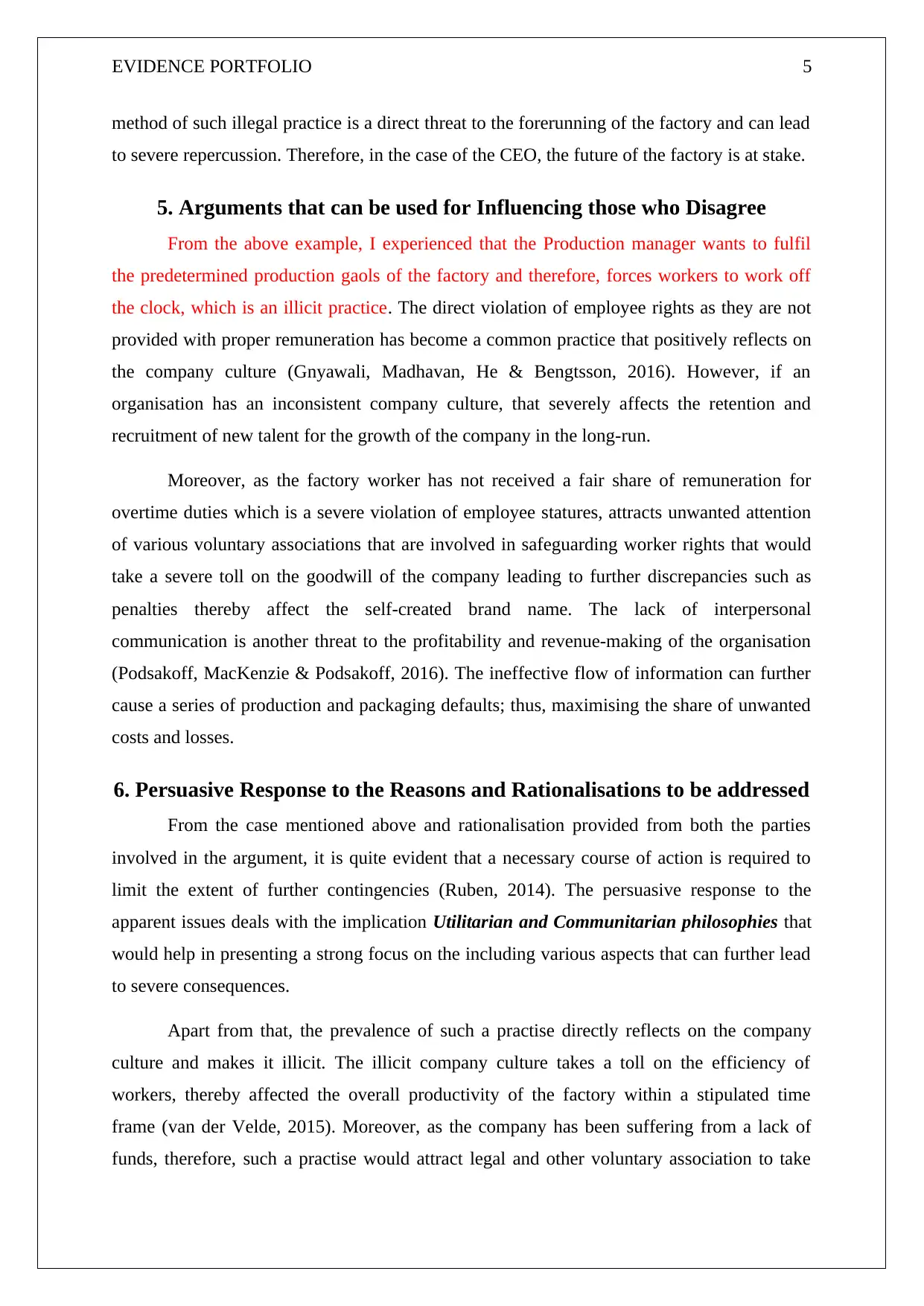
EVIDENCE PORTFOLIO 5
method of such illegal practice is a direct threat to the forerunning of the factory and can lead
to severe repercussion. Therefore, in the case of the CEO, the future of the factory is at stake.
5. Arguments that can be used for Influencing those who Disagree
From the above example, I experienced that the Production manager wants to fulfil
the predetermined production gaols of the factory and therefore, forces workers to work off
the clock, which is an illicit practice. The direct violation of employee rights as they are not
provided with proper remuneration has become a common practice that positively reflects on
the company culture (Gnyawali, Madhavan, He & Bengtsson, 2016). However, if an
organisation has an inconsistent company culture, that severely affects the retention and
recruitment of new talent for the growth of the company in the long-run.
Moreover, as the factory worker has not received a fair share of remuneration for
overtime duties which is a severe violation of employee statures, attracts unwanted attention
of various voluntary associations that are involved in safeguarding worker rights that would
take a severe toll on the goodwill of the company leading to further discrepancies such as
penalties thereby affect the self-created brand name. The lack of interpersonal
communication is another threat to the profitability and revenue-making of the organisation
(Podsakoff, MacKenzie & Podsakoff, 2016). The ineffective flow of information can further
cause a series of production and packaging defaults; thus, maximising the share of unwanted
costs and losses.
6. Persuasive Response to the Reasons and Rationalisations to be addressed
From the case mentioned above and rationalisation provided from both the parties
involved in the argument, it is quite evident that a necessary course of action is required to
limit the extent of further contingencies (Ruben, 2014). The persuasive response to the
apparent issues deals with the implication Utilitarian and Communitarian philosophies that
would help in presenting a strong focus on the including various aspects that can further lead
to severe consequences.
Apart from that, the prevalence of such a practise directly reflects on the company
culture and makes it illicit. The illicit company culture takes a toll on the efficiency of
workers, thereby affected the overall productivity of the factory within a stipulated time
frame (van der Velde, 2015). Moreover, as the company has been suffering from a lack of
funds, therefore, such a practise would attract legal and other voluntary association to take
method of such illegal practice is a direct threat to the forerunning of the factory and can lead
to severe repercussion. Therefore, in the case of the CEO, the future of the factory is at stake.
5. Arguments that can be used for Influencing those who Disagree
From the above example, I experienced that the Production manager wants to fulfil
the predetermined production gaols of the factory and therefore, forces workers to work off
the clock, which is an illicit practice. The direct violation of employee rights as they are not
provided with proper remuneration has become a common practice that positively reflects on
the company culture (Gnyawali, Madhavan, He & Bengtsson, 2016). However, if an
organisation has an inconsistent company culture, that severely affects the retention and
recruitment of new talent for the growth of the company in the long-run.
Moreover, as the factory worker has not received a fair share of remuneration for
overtime duties which is a severe violation of employee statures, attracts unwanted attention
of various voluntary associations that are involved in safeguarding worker rights that would
take a severe toll on the goodwill of the company leading to further discrepancies such as
penalties thereby affect the self-created brand name. The lack of interpersonal
communication is another threat to the profitability and revenue-making of the organisation
(Podsakoff, MacKenzie & Podsakoff, 2016). The ineffective flow of information can further
cause a series of production and packaging defaults; thus, maximising the share of unwanted
costs and losses.
6. Persuasive Response to the Reasons and Rationalisations to be addressed
From the case mentioned above and rationalisation provided from both the parties
involved in the argument, it is quite evident that a necessary course of action is required to
limit the extent of further contingencies (Ruben, 2014). The persuasive response to the
apparent issues deals with the implication Utilitarian and Communitarian philosophies that
would help in presenting a strong focus on the including various aspects that can further lead
to severe consequences.
Apart from that, the prevalence of such a practise directly reflects on the company
culture and makes it illicit. The illicit company culture takes a toll on the efficiency of
workers, thereby affected the overall productivity of the factory within a stipulated time
frame (van der Velde, 2015). Moreover, as the company has been suffering from a lack of
funds, therefore, such a practise would attract legal and other voluntary association to take
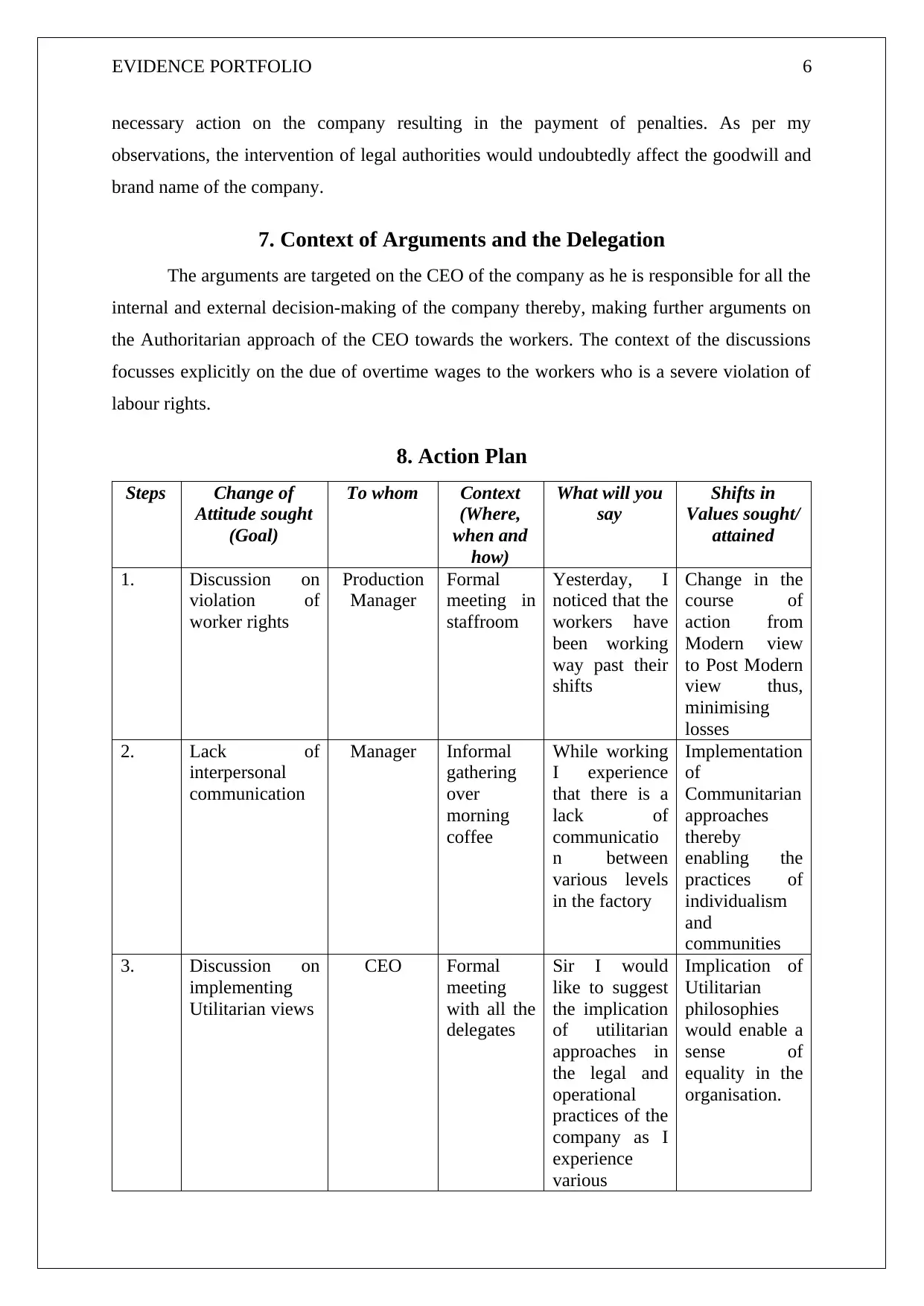
EVIDENCE PORTFOLIO 6
necessary action on the company resulting in the payment of penalties. As per my
observations, the intervention of legal authorities would undoubtedly affect the goodwill and
brand name of the company.
7. Context of Arguments and the Delegation
The arguments are targeted on the CEO of the company as he is responsible for all the
internal and external decision-making of the company thereby, making further arguments on
the Authoritarian approach of the CEO towards the workers. The context of the discussions
focusses explicitly on the due of overtime wages to the workers who is a severe violation of
labour rights.
8. Action Plan
Steps Change of
Attitude sought
(Goal)
To whom Context
(Where,
when and
how)
What will you
say
Shifts in
Values sought/
attained
1. Discussion on
violation of
worker rights
Production
Manager
Formal
meeting in
staffroom
Yesterday, I
noticed that the
workers have
been working
way past their
shifts
Change in the
course of
action from
Modern view
to Post Modern
view thus,
minimising
losses
2. Lack of
interpersonal
communication
Manager Informal
gathering
over
morning
coffee
While working
I experience
that there is a
lack of
communicatio
n between
various levels
in the factory
Implementation
of
Communitarian
approaches
thereby
enabling the
practices of
individualism
and
communities
3. Discussion on
implementing
Utilitarian views
CEO Formal
meeting
with all the
delegates
Sir I would
like to suggest
the implication
of utilitarian
approaches in
the legal and
operational
practices of the
company as I
experience
various
Implication of
Utilitarian
philosophies
would enable a
sense of
equality in the
organisation.
necessary action on the company resulting in the payment of penalties. As per my
observations, the intervention of legal authorities would undoubtedly affect the goodwill and
brand name of the company.
7. Context of Arguments and the Delegation
The arguments are targeted on the CEO of the company as he is responsible for all the
internal and external decision-making of the company thereby, making further arguments on
the Authoritarian approach of the CEO towards the workers. The context of the discussions
focusses explicitly on the due of overtime wages to the workers who is a severe violation of
labour rights.
8. Action Plan
Steps Change of
Attitude sought
(Goal)
To whom Context
(Where,
when and
how)
What will you
say
Shifts in
Values sought/
attained
1. Discussion on
violation of
worker rights
Production
Manager
Formal
meeting in
staffroom
Yesterday, I
noticed that the
workers have
been working
way past their
shifts
Change in the
course of
action from
Modern view
to Post Modern
view thus,
minimising
losses
2. Lack of
interpersonal
communication
Manager Informal
gathering
over
morning
coffee
While working
I experience
that there is a
lack of
communicatio
n between
various levels
in the factory
Implementation
of
Communitarian
approaches
thereby
enabling the
practices of
individualism
and
communities
3. Discussion on
implementing
Utilitarian views
CEO Formal
meeting
with all the
delegates
Sir I would
like to suggest
the implication
of utilitarian
approaches in
the legal and
operational
practices of the
company as I
experience
various
Implication of
Utilitarian
philosophies
would enable a
sense of
equality in the
organisation.
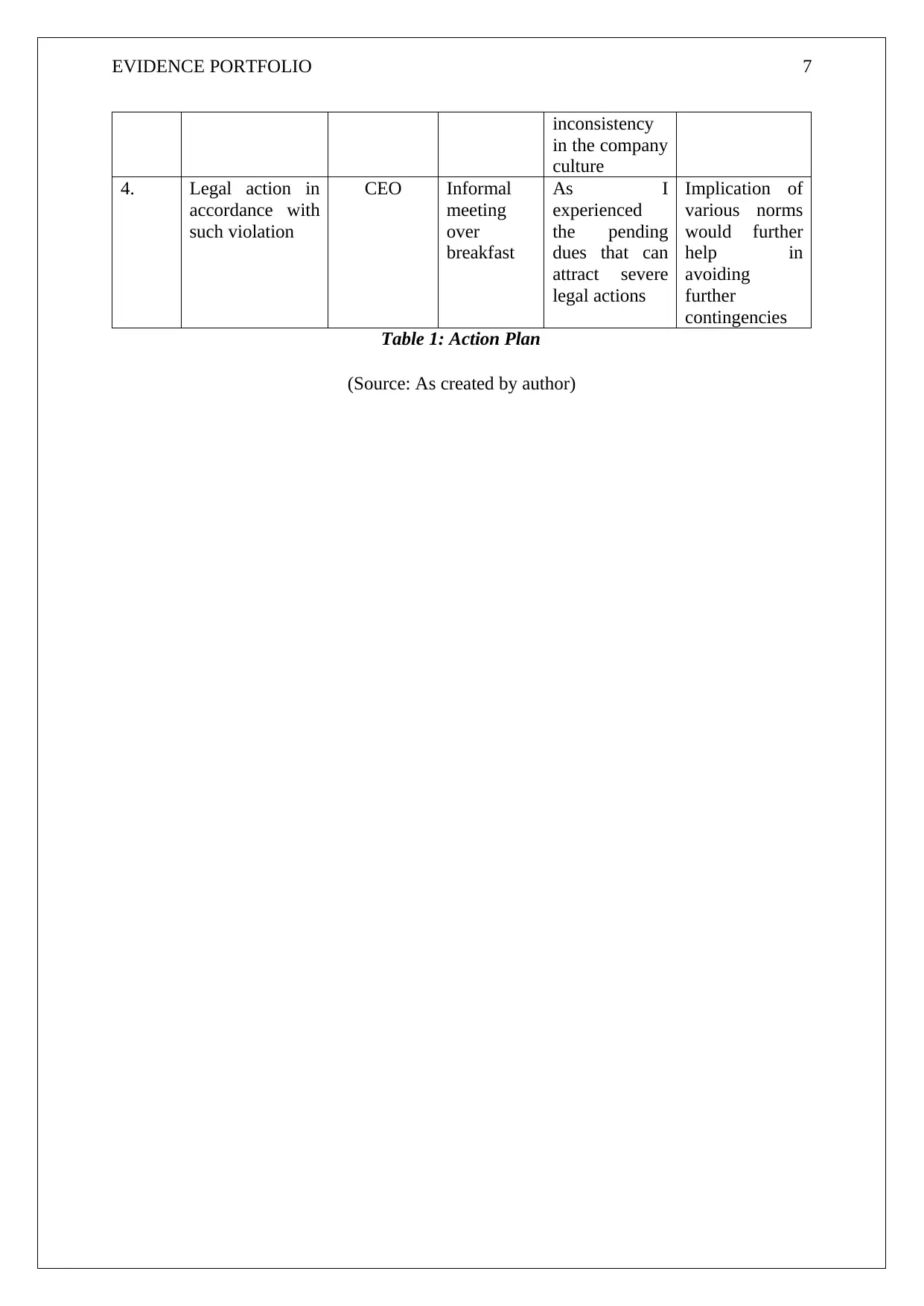
EVIDENCE PORTFOLIO 7
inconsistency
in the company
culture
4. Legal action in
accordance with
such violation
CEO Informal
meeting
over
breakfast
As I
experienced
the pending
dues that can
attract severe
legal actions
Implication of
various norms
would further
help in
avoiding
further
contingencies
Table 1: Action Plan
(Source: As created by author)
inconsistency
in the company
culture
4. Legal action in
accordance with
such violation
CEO Informal
meeting
over
breakfast
As I
experienced
the pending
dues that can
attract severe
legal actions
Implication of
various norms
would further
help in
avoiding
further
contingencies
Table 1: Action Plan
(Source: As created by author)
Paraphrase This Document
Need a fresh take? Get an instant paraphrase of this document with our AI Paraphraser
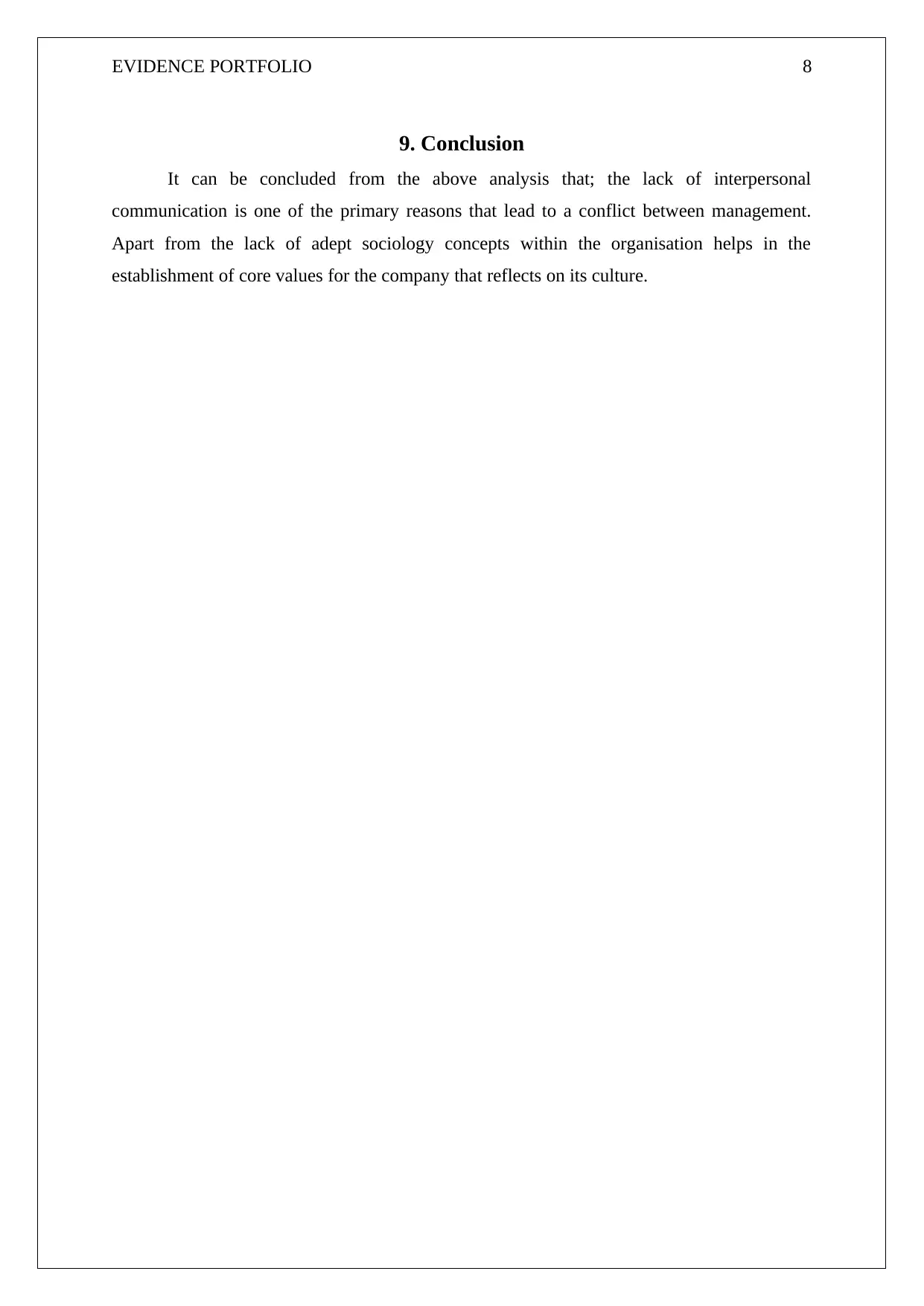
EVIDENCE PORTFOLIO 8
9. Conclusion
It can be concluded from the above analysis that; the lack of interpersonal
communication is one of the primary reasons that lead to a conflict between management.
Apart from the lack of adept sociology concepts within the organisation helps in the
establishment of core values for the company that reflects on its culture.
9. Conclusion
It can be concluded from the above analysis that; the lack of interpersonal
communication is one of the primary reasons that lead to a conflict between management.
Apart from the lack of adept sociology concepts within the organisation helps in the
establishment of core values for the company that reflects on its culture.
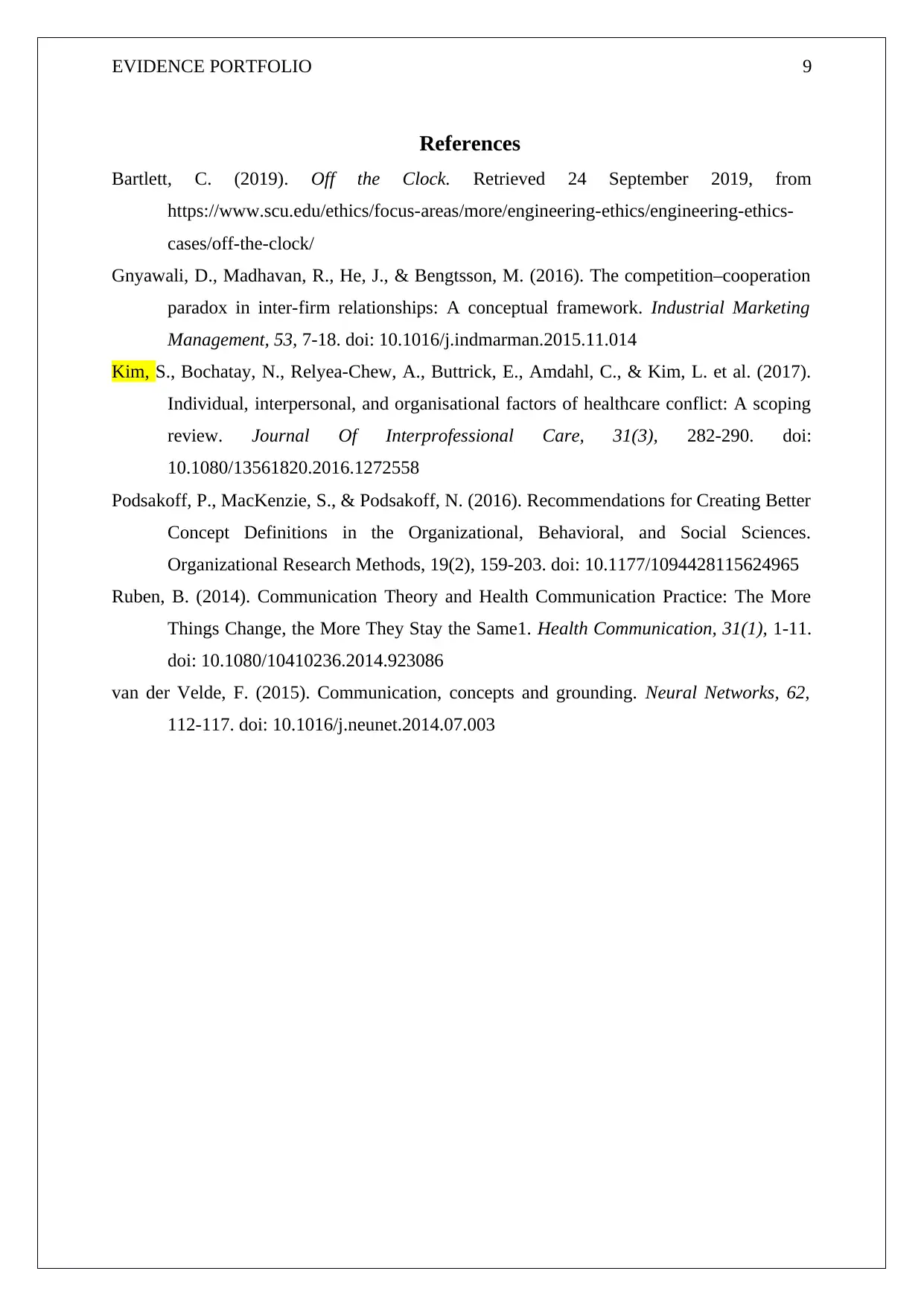
EVIDENCE PORTFOLIO 9
References
Bartlett, C. (2019). Off the Clock. Retrieved 24 September 2019, from
https://www.scu.edu/ethics/focus-areas/more/engineering-ethics/engineering-ethics-
cases/off-the-clock/
Gnyawali, D., Madhavan, R., He, J., & Bengtsson, M. (2016). The competition–cooperation
paradox in inter-firm relationships: A conceptual framework. Industrial Marketing
Management, 53, 7-18. doi: 10.1016/j.indmarman.2015.11.014
Kim, S., Bochatay, N., Relyea-Chew, A., Buttrick, E., Amdahl, C., & Kim, L. et al. (2017).
Individual, interpersonal, and organisational factors of healthcare conflict: A scoping
review. Journal Of Interprofessional Care, 31(3), 282-290. doi:
10.1080/13561820.2016.1272558
Podsakoff, P., MacKenzie, S., & Podsakoff, N. (2016). Recommendations for Creating Better
Concept Definitions in the Organizational, Behavioral, and Social Sciences.
Organizational Research Methods, 19(2), 159-203. doi: 10.1177/1094428115624965
Ruben, B. (2014). Communication Theory and Health Communication Practice: The More
Things Change, the More They Stay the Same1. Health Communication, 31(1), 1-11.
doi: 10.1080/10410236.2014.923086
van der Velde, F. (2015). Communication, concepts and grounding. Neural Networks, 62,
112-117. doi: 10.1016/j.neunet.2014.07.003
References
Bartlett, C. (2019). Off the Clock. Retrieved 24 September 2019, from
https://www.scu.edu/ethics/focus-areas/more/engineering-ethics/engineering-ethics-
cases/off-the-clock/
Gnyawali, D., Madhavan, R., He, J., & Bengtsson, M. (2016). The competition–cooperation
paradox in inter-firm relationships: A conceptual framework. Industrial Marketing
Management, 53, 7-18. doi: 10.1016/j.indmarman.2015.11.014
Kim, S., Bochatay, N., Relyea-Chew, A., Buttrick, E., Amdahl, C., & Kim, L. et al. (2017).
Individual, interpersonal, and organisational factors of healthcare conflict: A scoping
review. Journal Of Interprofessional Care, 31(3), 282-290. doi:
10.1080/13561820.2016.1272558
Podsakoff, P., MacKenzie, S., & Podsakoff, N. (2016). Recommendations for Creating Better
Concept Definitions in the Organizational, Behavioral, and Social Sciences.
Organizational Research Methods, 19(2), 159-203. doi: 10.1177/1094428115624965
Ruben, B. (2014). Communication Theory and Health Communication Practice: The More
Things Change, the More They Stay the Same1. Health Communication, 31(1), 1-11.
doi: 10.1080/10410236.2014.923086
van der Velde, F. (2015). Communication, concepts and grounding. Neural Networks, 62,
112-117. doi: 10.1016/j.neunet.2014.07.003
1 out of 9
Your All-in-One AI-Powered Toolkit for Academic Success.
+13062052269
info@desklib.com
Available 24*7 on WhatsApp / Email
![[object Object]](/_next/static/media/star-bottom.7253800d.svg)
Unlock your academic potential
© 2024 | Zucol Services PVT LTD | All rights reserved.